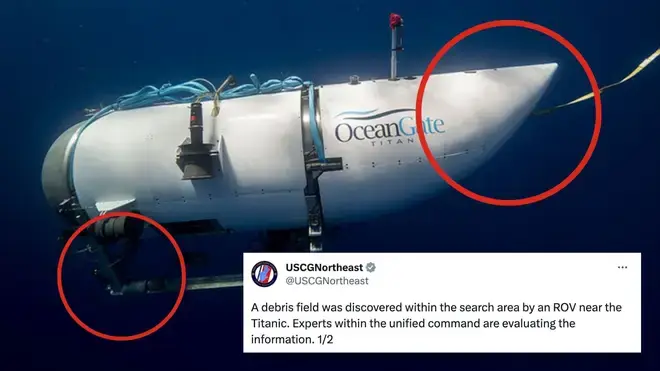
James Hanson 4am - 7am
23 June 2023, 06:46

Navy officials in the US detected the sound of an implosion shortly after a submersible lost contact.
It was recorded by a secret acoustic monitoring system designed to detect submarines, The Wall Street Journal reported.
A senior US Navy official told the newspaper: “The US Navy conducted an analysis of acoustic data and detected an anomaly consistent with an implosion or explosion in the general vicinity of where the Titan submersible was operating when communications were lost.
“While not definitive, this information was immediately shared with the Incident Commander to assist with the ongoing search and rescue mission.”

Submersible lost on dive to Titanic suffered 'catastrophic implosion' – US Coast Guard
Following the submersible's disappearance on Sunday, the US Navy reviewed its acoustic data and discovered an anomaly aligned with an implosion or explosion, according to a senior Navy official who spoke to the Associated Press.
This anomaly was found in the general vicinity of where the Titan submersible was operating when communication was lost.
The Navy relayed this information to the Coast Guard, which continued its search efforts.
Steffan Watkins, an aircraft and naval research consultant, told The Telegraph the US Navy had spent a huge sum on building a new, deep-sea sensor network in the past five years “that they don’t talk about”.
He said: “They’re deploying underwater detection tech that’s supposed to detect the most advanced, quietest subs, so I’d expect narco ‘subs’ and sketchy submersibles that implode must be child’s play for them.”
Read more: James Cameron 'struck by similarity' between Titan sub tragedy and sinking of the Titanic in 1912

Marr Monologue 22/06
Mark Cancian, a senior adviser at the Center for Strategic and International Studies, remarked that he would have been surprised if the US military's sensors had not detected the implosion.
He explained that although they suspected what had occurred, they couldn't be entirely certain due to the nature of the data—lines on a graph.
Cancian explained that simply relying on graph patterns to justify not conducting a search would not be acceptable to many.
“And if you try to convince people you weren’t doing a search because the lines on a graph indicated an implosion, that wouldn’t be acceptable to many.”
On Thursday, the US Coast Guard announced the discovery of wreckage from the submersible in close proximity to the remains of the Titanic, which rests 12,400 feet beneath the ocean's surface.
The four-day search-and-rescue operation concluded with officials finding debris on the sea floor that was consistent with the implosion of the submersible's pressure chamber.
OceanGate Expeditions, the operator of the submersible, declared the five passengers as presumed dead.
US Coast Guard Rear Admiral John Mauger noted that it was too early to determine if the implosion occurred at the time of the submersible's last communication on Sunday.
Additionally, the sonar buoys used by the search teams that arrived later did not detect the implosion.
The Coast Guard will continue searching near the Titanic for further clues regarding the incident involving the Titan.
Efforts to recover the submersible and the remains of the five deceased individuals will also persist.